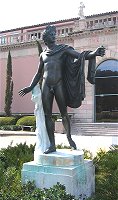Apollo BelvedereMuseum Label: Chiurazzi description: Origin: Museo Vaticano |
Subject info:
The Apollo Belvedere is a marble sculpture that was discovered in the late 15th century.
Much of the left forearm and some of the right hand were missing, but Antico in his
statuette completed the extremities, and after arrival in Rome in 1532 Montorsoli made
additions to the marble itself, which were observed with hardly any comment and invariably
reproduced in prints, casts and copies for over 3 centuries but have recently been
removed.
Some thought that the marble sculpture had been removed from Greece by Nero, but later analysis showed the marble composition to be Italian. Others thought that it must have been a copy of a Greek bronze sculpture, since a tree stump is attached to the right leg, which was usually done in bronze sculptures for sturdiness.
For centuries the sculpture epitomized the ideals of Classical Antiquity for Europeans,
from the Renaissance through the 19th century. Since the marble sculpture includes
In the 1530s it was engraved by Marcantonio Raimondi, whose printed image transmitted the
famous pose throughout Europe. Before his engraving existed, the Mantuan sculptor Pier
Jacopo Alari Bonacolsi, called "L'Antico", had made a careful wax model of it,
which he cast in bronze, finely finished and partly gilded, to figure in the Gonzaga
collection, and in further copies in a handful of others. Albrecht D rer reversed the
Apollo's pose for his Adam in a 1504 engraving of Adam and Eve, suggesting that he saw it
in Rome. When L'Antico and D rer saw it, the Apollo was probably still in the personal
collection of Giuliano della Rovere, who, once he was pope as Julius II, transferred the
prize in 1511 to the small sculpture court of the Belvedere, the palazzetto or summerhouse
that was linked to the Vatican Palace by Bramante's large Cortile del Belvedere. It became
the Apollo of the Cortile del Belvedere and the name has remained with it, though the
sculpture has long been indoors, in the Museo Pio-Clementino at the Vatican Museums, Rome.
Some experts believe that the marble is probably a Hellenistic or Roman copy of a bronze
original, maybe by the Greek sculptor Leochares, made between 350—325 BC. For
centuries it was treasured as the most celebrated work of Greek sculpture. Presently more
experts see it as Roman style. The neoclassical sculptor Antonio Canova adopted the fluent
Apollo Belvedere for his marble Perseus (Metropolitan Museum).
Apollo:
Apollo is in many respects the paradigm of a Greek god. He represents order, harmony, and
civilization in a way that most other Olympian deities cannot quite equal. One only has to
compare him with Dionysos to understand how Apollo is depicted as a bright, rational
counterpart to the chaotic and frenzied god of wine and women. Indeed, Apollo is most
often associated with the cultivated arts of music and medicine, and his role as the
leader of the Muses establishes him as a patron of intellectual pursuits.
Therefore, it comes as no surprise that in art, images of Apollo represented the height of
male attractiveness - indeed, for years, Archaic statues of youths were commonly referred
to as "Apollo", later to be replaced the more accurate term "kouros"
(young man). However, as with most Greek deities, Apollo has characteristics that are
myriad and diverse, so we should proceed to an exploration of this important god.
Birth of Apollo
According to the Greek poet Hesiod (Theogony, 918-20), Apollo was the son of the Olympian
Zeus and the Titan Leto, and the brother of the goddess Artemis. And the details of how
Apollo and his sister were born make an intriguing story, so let us look at this legend
more closely.
The myth of Apollo's birth includes another instance of the wrath of Hera. Again, the wife
of the philandering Zeus discovered that her husband had impregnated yet another goddess,
and this time it was the Titan Leto. In her anger, Hera would not allow Leto to bear her
children (remember, she was pregnant with the twin gods Apollo and Artemis), and the land
itself was afraid to provide a shelter for Leto because of the fear of Hera's notorious
retribution. Finally, Leto found an island that was willing to allow her to give birth,
and this island was named Delos (which means "brilliant", and, incidentally,
inspired the epithet Delian) in honor of the divine site. Apollo was then cared for by
Themis, who fed him nectar and ambrosia for a few days, after which time he was an adult
capable of assuming the full responsibilities of a god. And this is the story of how
Apollo was born in Greek mythology.
